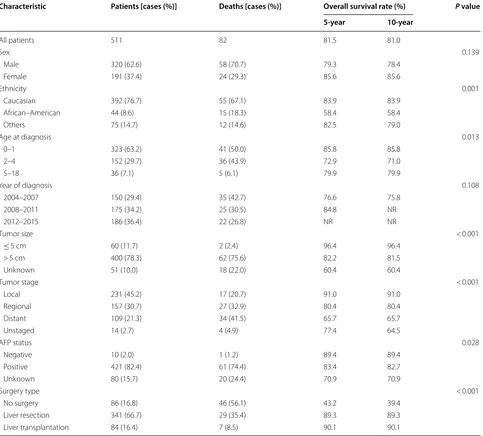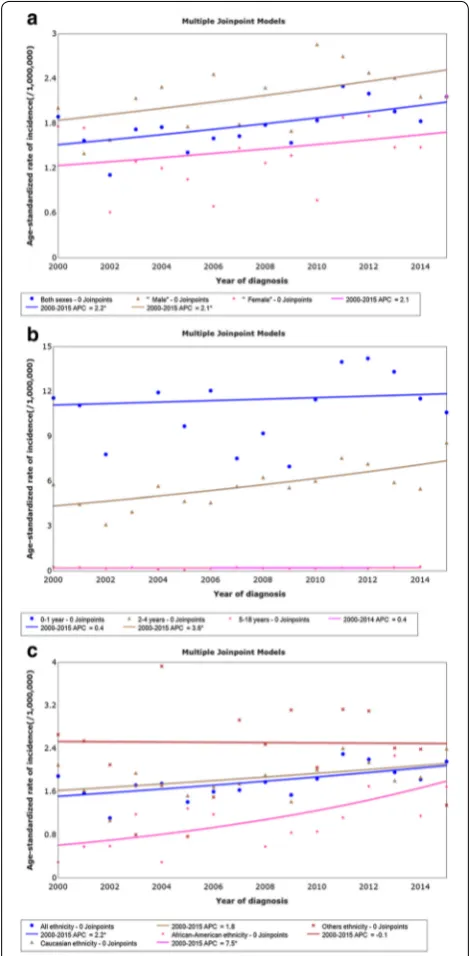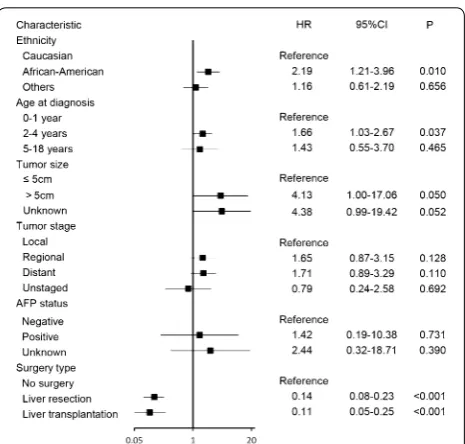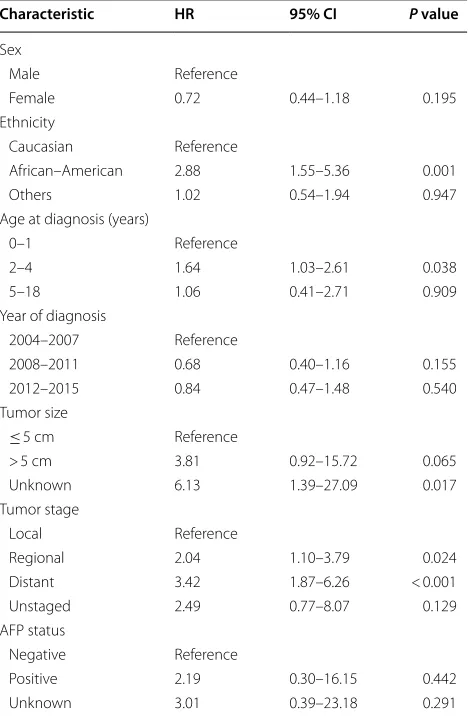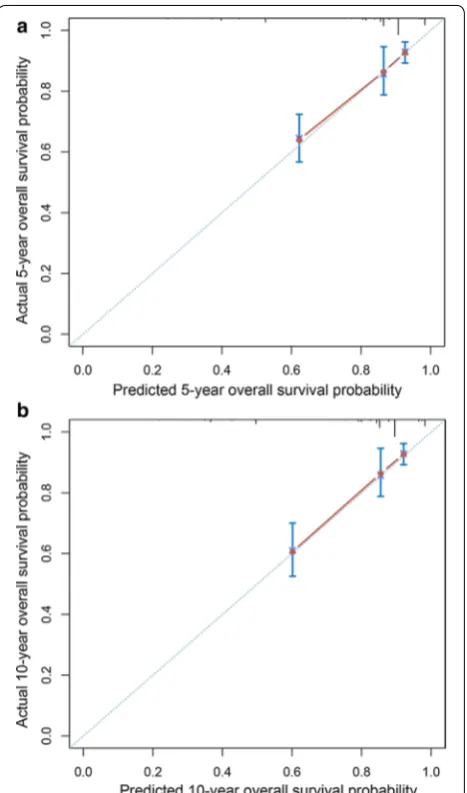ORIGINAL ARTICLE
Incidence trends and survival
prediction of hepatoblastoma in children:
a population-based study
Jincheng Feng
1†, Georgios Polychronidis
1†, Ulrike Heger
1, Giovanni Frongia
2, Arianeb Mehrabi
1and Katrin Hoffmann
1*Abstract
Background: Hepatoblastoma is a rare disease that nevertheless accounts for the majority of liver malignancies in children. Due to limited epidemiological data, therapy for hepatoblastoma tends to be individualized. This study aimed to evaluate incidence trends of hepatoblastoma and to develop a nomogram to predict the survival of children with newly diagnosed hepatoblastoma on a population-based level.
Methods: Individuals up to 18 years of age with hepatoblastoma recorded in 18 registries of the Surveillance, Epi-demiology, and End Results (SEER) database between 2004 and 2015 were examined. Joinpoint regression analyses were applied to assess incidence trends in annual percentage change (APC). Multivariable Cox regression was used to identify factors associated with overall survival (OS). A nomogram was constructed to predict OS in individual cases based on independent predictors. Concordance index (C-index) and calibration curves were used to evaluate predic-tive performance.
Results: Between 2004 and 2015, hepatoblastoma incidence increased significantly (APC, 2.2%; 95% confidence interval [CI] 0.5% to 3.8%, P < 0.05). In particular, this increase was observed among 2- to 4-year-old patients, males, and African–Americans. The 5- and 10-year OS rates were 81.5% and 81.0%, respectively. Age of 2 to 4 years, Afri-can–American ethnicity, and no surgery were independent predictors for short OS. Distant disease at presentation was found not to be an independent factor of survival. The nomogram had a C-index of 0.79 (95% CI 0.74–0.84) with appropriate calibration curve fitting.
Conclusions: We constructed a nomogram that integrates common factors associated with survival for hepatoblas-toma patients. It provides accurate prognostic prediction for children with hepatoblashepatoblas-toma.
Keywords: Hepatoblastoma, Liver surgery, Liver transplantation, Pediatric surgery, SEER, Incidence, Overall survival, Nomogram
© The Author(s) 2019. This article is distributed under the terms of the Creative Commons Attribution 4.0 International License (http://creativecommons.org/licenses/by/4.0/), which permits unrestricted use, distribution, and reproduction in any medium, provided you give appropriate credit to the original author(s) and the source, provide a link to the Creative Commons license, and indicate if changes were made. The Creative Commons Public Domain Dedication waiver (http://creativecommons.org/ publicdomain/zero/1.0/) applies to the data made available in this article, unless otherwise stated.
Background
Liver tumors among children are relatively rare, accounting for approximately 1% of all childhood malig-nancies [1–4]. The overall age-standardized rate of inci-dence (world standard) of liver tumors in children was
2.3 per million person-years between 2001 and 2010 worldwide [5]. Hepatoblastoma is the most common malignant liver tumor in children, with an increase in incidence of 4.3% per year, from 1992 to 2004, in chil-dren younger than 19 years [1, 4, 6, 7]. Hepatoblas-toma is most frequently diagnosed in children less than 5 years of age [3, 7–9]. Treatment of hepatoblastoma includes chemotherapy, surgical resection, and liver transplantation [10]. Complete surgical resection is the first-line treatment for resectable hepatoblastoma at initial diagnosis, and liver transplantation is one of the
Open Access
*Correspondence: Katrin.Hoffmann@med.uni-heidelberg.de
†Jincheng Feng and Georgios Polychronidis contributed equally to this
work
1 Department of General, Visceral and Transplant Surgery, University
main treatments for unresectable hepatoblastoma [11– 13]. Survival outcomes have greatly improved over the past four decades [10, 11, 14, 15]. Although the prog-nostic factors and prognosis of hepatoblastoma have been reported in some population-based studies [8, 14, 16, 17], nomograms to predict long-term survival for patients with hepatoblastoma are still lacking.
Nomograms have been developed for some cancers and are accepted as reliable tools for individualized risk prediction [18–21]. Given the rarity of hepatoblastoma as well as the small sample sizes of retrospective stud-ies [11, 15, 22–24], a large population-based study is needed. Therefore, we analyzed the incidence trends and clinical outcomes of hepatoblastoma in children using the data from 18 cancer registries of the Sur-veillance, Epidemiology, and End Results (SEER) data-base, which is supported by the Surveillance Research Program (SRP) of Division of Cancer Control and Population Sciences (DCCPS) of the National Cancer Institute (NCI), and constructed a prognostic nomo-gram to predict long-term survival of patients with hepatoblastoma.
Methods
Case selection from the SEER database
Data from the SEER database for year 2004–2015 were analyzed. The selection criteria were patients of 0 to 18 years old who were newly diagnosed with hepatoblas-toma between January 1, 2004 and December 31, 2015. Exclusion criteria were unknown ethnicity, unknown surgical intervention, and lack of up. The follow-ing variables were obtained from the SEER database for further analysis: sex, age at diagnosis, ethnicity, year of diagnosis, tumor size, tumor stage, alpha-fetoprotein (AFP) status, and surgery at the primary site.
Definition of variables
Because the Union for International Cancer Control (UICC) tumor-node-metastasis (TNM) staging system is not used for hepatoblastoma cases in the SEER database, the SEER summary staging guidelines [25] were used to evaluate tumor stage in this analysis. The SEER vari-able “Summary Stage 2000 (1998+)” describes a surgical
procedure that removes and/or destroys the tissue at the primary site performed as part of the initial work-up or first course of therapy. This enabled classifying cases into four categories: local, regional, distant, and unstaged. The SEER surgery codes recorded data on liver-directed surgical treatments, which were categorized as no sur-gery, liver resection, and liver transplantation. Sex was classified as male and female. The SEER program classi-fied ethnicity into three categories: Caucasian ethnicity,
African–American ethnicity, and other ethnicities (American Indian/Alaska Native, Asian/Pacific Islander). Age at diagnosis was classified into three groups: 0–1, 2–4, and 5–18 years old. Year of diagnosis was divided into three time periods: 2004–2007, 2008–2011, and 2012–2015. Tumor size was also classified into three cat-egories: ≤ 5 cm, > 5 cm, and unknown. AFP status was classified into three categories: positive, negative, and unknown (according to the SEER database). Because all patient information in the SEER database is de-identified, this study was exempted from review by the Institutional Review Board.
Statistical analysis
The age-standardized incidence of hepatoblastoma according to the 2000 US Standard Population was iden-tified in the cancer registries of the SEER database [26]. The annual percentage change (APC) of incidence was calculated using the weighted least squares method. We analyzed the incidence of hepatoblastoma stratified by sex, age at diagnosis, and ethnicity. Joinpoint regression analyses (v. 4.6.0, IMS, Calverton, MD, USA) were used to analyze incidence trends from 2000 to 2015. Over-all survival (OS) was estimated using the Kaplan–Meier method, and the log-rank test was used to compare sur-vival curves. OS was defined as the period from diagnosis to death of any cause. For individuals who were still alive at the time of the last follow-up, OS was censored at the date of last follow-up or December 31, 2015, whichever came first.
A Cox proportional hazards model was applied for mul-tivariate survival analysis. Those variables with a P value less than 0.05 in the univariate analysis were entered into a Cox proportional hazards model to identify inde-pendent predictors of OS. A nomogram was constructed based on the results of the multivariate analysis. Nomo-gram performance was measured using the concordance index (C-index). The larger the C-index, the more accu-rate the prognostic prediction proved to be. The nomo-gram was subjected to 1000 bootstraps resamples for internal validation. Calibration of the nomogram for 5- and 10-year OS was performed by comparing predicted survival with observed survival. The data were analyzed using SPSS version 20.0 for Windows (SPSS Inc., Chi-cago, IL, USA) and R software version 3.5.0 (https :// www.r-proje ct.org/). All P values were two-sided, and a P
value < 0.05 was regarded as statistically significant.
Results
Patient demographics
morphology codes from the third edition of the Inter-national Classification of Diseases for Oncology (ICD-O-3). Of these 523 cases, we excluded 12 due to lack of data on ethnicity (n= 7), surgery (n= 2), or follow-up (n= 3). The remaining 511 cases were selected for this study. The median age at diagnosis was 1 year old (range 0–17 years). The majority of patients were males (62.6%), of Caucasian ethnicity (76.7%), and had a positive AFP status (82.4%). Surgery was performed on 425 (83.2%) patients. Of them, 341 (66.7%) received a liver resection, and 84 (16.4%) had liver transplantation. Baseline patient demographics and tumor characteristics are shown in Table 1.
Incidence trends
The incidence of hepatoblastoma increased from 1.89 per 1,000,000 in 2000 to 2.16 per 1,000,000 in 2015, with an APC of 2.2% (95% confidence interval [CI] 0.5% to 3.8%, P = 0.014). We identified a significant increase
in hepatoblastoma incidence from 2000 to 2015 in the male population with an APC of 2.1% (95% CI 0.1% to 4.2%, P= 0.047). The rise in incidence was not signifi-cant among females (APC = 2.1%, 95% CI − 1.3% to 5.6%,
P =0.218) (Fig. 1a). Age-adjusted incidences (95% CI)
were 11.19 (9.71–12.82) per 1,000,000 in the 0- to 1-year-old age group, 5.66 (5.13–6.24) per 1,000,000 in the 2- to 4-year-old age group, and 0.18 (0.14–0.24) per 1,000,000
Table 1 Demographic and clinicopathologic characteristics, and overall survival of patients with hepatoblastoma
NR not reached, AFP alpha-fetoprotein
Characteristic Patients [cases (%)] Deaths [cases (%)] Overall survival rate (%) P value
5-year 10-year
All patients 511 82 81.5 81.0
Sex 0.139
Male 320 (62.6) 58 (70.7) 79.3 78.4
Female 191 (37.4) 24 (29.3) 85.6 85.6
Ethnicity 0.001
Caucasian 392 (76.7) 55 (67.1) 83.9 83.9
African–American 44 (8.6) 15 (18.3) 58.4 58.4
Others 75 (14.7) 12 (14.6) 82.5 79.0
Age at diagnosis 0.013
0–1 323 (63.2) 41 (50.0) 85.8 85.8
2–4 152 (29.7) 36 (43.9) 72.9 71.0
5–18 36 (7.1) 5 (6.1) 79.9 79.9
Year of diagnosis 0.108
2004–2007 150 (29.4) 35 (42.7) 76.6 75.8
2008–2011 175 (34.2) 25 (30.5) 84.8 NR
2012–2015 186 (36.4) 22 (26.8) NR NR
Tumor size < 0.001
≤ 5 cm 60 (11.7) 2 (2.4) 96.4 96.4
> 5 cm 400 (78.3) 62 (75.6) 82.2 81.5
Unknown 51 (10.0) 18 (22.0) 60.4 60.4
Tumor stage < 0.001
Local 231 (45.2) 17 (20.7) 91.0 91.0
Regional 157 (30.7) 27 (32.9) 80.4 80.4
Distant 109 (21.3) 34 (41.5) 65.7 65.7
Unstaged 14 (2.7) 4 (4.9) 77.4 64.5
AFP status 0.028
Negative 10 (2.0) 1 (1.2) 89.4 89.4
Positive 421 (82.4) 61 (74.4) 83.4 82.7
Unknown 80 (15.7) 20 (24.4) 70.9 70.9
Surgery type < 0.001
No surgery 86 (16.8) 46 (56.1) 43.2 39.4
Liver resection 341 (66.7) 29 (35.4) 89.3 89.3
in the 5- to 18-year-old age group. Incidence among 2- to 4-year-old children increased significantly (APC = 3.6%, 95% CI 1.5% to 5.7%, P= 0.003), whereas the increase was not significant among 0- to 1-year-old children (APC = 0.4%, 95% CI − 2.2% to 3.2%, P= 0.803) or 5- to 18-year-old children (APC = 0.4%, 95% CI − 3.2% to 4.1%,
P= 0.782) (Fig. 1b). The incidence among African–Amer-icans also increased significantly (APC = 7.5%, 95% CI 2.5% to 12.8%, P= 0.006), which was not the case for Cau-casians (APC = 1.8%, 95% CI − 0.2% to 3.8%, P= 0.075) and patients of other ethnicities (APC =− 0.1%, 95% CI
− 4.4% to 4.4%, P= 0.945) (Fig. 1c).
Survival
The median follow-up was 45 months (range 0–143 months). Overall, 82 (16.0%) patients died dur-ing follow-up. Of these, 46 (56.1%) did not undergo sur-gery, 29 (35.4%) had liver resection, and 7 (8.5%) had liver transplantation. The 5- and 10-year OS rates were 81.5% and 81.0%, respectively. Risk factors associated with short OS included African–American ethnicity, an age of 2–4 years, distant disease at diagnosis, large tumor size (> 5 cm in diameter), positive AFP status, and not receiv-ing surgery (Table 1, Fig. 2). Type of surgery (liver resec-tion vs. transplantaresec-tion) did not have an impact on OS rate (P= 0.891).
Regression analysis using a multivariable Cox pro-portional hazards model revealed that age of 2–4 years (HR = 1.66, 95% CI 1.03–2.67, P= 0.037) and
Afri-can–American ethnicity (HR = 2.19, 95% CI 1.21–3.96,
P= 0.010) were independent predictors of shorter OS,
whereas liver resection (HR = 0.14, 95% CI 0.08–0.23,
P < 0.001) and liver transplantation (HR = 0.11, 95% CI
0.05–0.25, P < 0.001) were independent predictors of longer OS (Fig. 3). In a multivariate survival analysis that included all variables except for surgery type, tumor stage was found to be an independent factor for OS, but AFP status was still not an independent factor of OS (Table 2).
Nomogram for prediction of OS
We then constructed a nomogram that incorporated all significant prognostic factors identified through multi-variate analysis (Fig. 4). The nomogram showed that sur-gery was the most significant predictor of OS, followed by ethnicity and age. The nomogram also displayed a good C-index of 0.79 (95% CI 0.74–0.84) for predict-ing OS. The calibration plot for the probability of 5- and 10-year OS showed an optimal agreement between actual observation and the nomogram’s prediction (Fig. 5).
Discussion
In this population-based study, we assessed temporal trends in pediatric hepatoblastoma incidence and con-structed a nomogram to provide an individualized pre-diction of OS. The current analysis showed a significant annual increase (2.2%) in hepatoblastoma incidence between 2000 and 2015. Although management of this disease has evolved over the past 30 years, there is no Fig. 1 Hepatoblastoma incidence trends by sex (a), age at diagnosis
(b), and ethnicity (c) among patients aged less than 18 recorded in 18 registries of the SEER database, 2004 to 2015. *APCs significantly different than zero at the 5% level, calculated based on a two-sided t
test. SEER the Surveillance, Epidemiology, and End Results database,
model for predicting OS of hepatoblastoma patients. The constructed nomogram was found to be accurate in prognostic prediction for hepatoblastoma patients, with a C-index of 0.79.
Owing to the rarity of hepatoblastoma, single-insti-tution data were insufficient for assessing its incidence trends. Until now, only a few population-based studies have reported hepatoblastoma incidence trends in the past few decades. Darbari et al. [1] reported the incidence of primary liver malignancies among U.S. children aged less than 20 years from 1973 to 1997, using the SEER database. They found that hepatoblastoma incidence had increased, with age-adjusted incidences of 1.09 per 1,000,000 for the whole cohort, 1.22 per 1,000,000 for males, and 0.96 per 1,000,000 for females. However, clini-cal outcomes and prognostic factors were not reported. In another SEER study of 606 patients diagnosed with hepatoblastoma between 1973 and 2009, Allan et al. [8] found a significant increase in the overall age-adjusted incidence of hepatoblastoma with an APC of 2.18%. However, the reported incidence was not stratified by sex and age. Although outcomes and prognostic factors were reported, the study did not provide a new prognos-tic model. A recent population-based study analyzing the Taiwan Cancer Registry (TCR) database reported that, from 1995 to 2012, the overall incidence of hepa-toblastoma in children increased by 7.4% per year and, specifically, by 6.5% among males [16]. In that study, the incidence of hepatoblastoma was analyzed according to sex and age. However, no outcomes were reported. In the Fig. 2 Kaplan–Meier overall survival curves of hepatoblastoma patients stratified by ethnicity (a), age at diagnosis (b), tumor stage (c), tumor size (d), AFP status (e), and treatment (f)
present study, we have provided updated information on hepatoblastoma incidence trends. We found that its inci-dence increased by 2.2% annually from 2000 to 2015 and, notably, that the incidence increased most significantly among males and in 2- to 4-year-old children.
In the past decades, the management of hepatoblas-toma has evolved to include not only surgical treatments such as liver resection and transplantation but also non-surgical treatments such as chemotherapy. Progress in treatment has contributed to prolonged OS in patients with hepatoblastoma. The 10-year OS rate was 81.0% in our analysis, which was better than 61% reported in a SEER-based analysis from 1973 to 2009 [8]. In a single-center retrospective study involving 30 patients younger than 18 years who underwent liver transplantation for hepatoblastoma between 1997 and 2014 at Stanford Uni-versity School of Medicine, Pham et al. [11] reported
10-year disease-free survival and OS rates of 82% and 84%, respectively. In another SEER study including 318 hepatoblastoma patients undergoing surgery between 1998 and 2009, McAteer et al. [27] found that the over-all 5-year disease-specific survival rate was 85.7%, and the rates for patients undergoing resection and trans-plantation were essentially equivalent (85.6% vs. 86.5%,
P= 0.66). In the present study, patients who underwent liver resection (n= 341) and liver transplantation (n= 84) had comparable 10-year OS rates (89.3% vs. 90.1%,
P= 0.891).
Surgery, ethnicity, and age were identified as independ-ent prognostic factors in the presindepend-ent study. Surgery was a strong predictor of OS. Moreover, the need for liver resection has increased over time: the number of patients receiving liver resection for hepatoblastoma increased by 1.4 folds between the time frames of 2004–2007 and 2012–2015. However, this increase was not observed in patients that received liver transplantation. The num-ber of patients who underwent liver transplantation remained relatively constant between 2004–2007 and 2012–2015. These data emphasize that more children now have the opportunity for a possible cure by surgical resection. With advances in surgical management and chemotherapy, the 5-year OS rate for children with hepa-toblastoma has increased to more than 80%. In the cur-rent study, we included patients diagnosed between 2004 and 2015 that had been reported in SEER. There is no doubt that these patients mainly benefited from efficient Table 2 Multivariate Cox regression analysis including all
variables without surgery type for overall survival of hepatoblastoma patients
HR hazard ratio, CI confidence interval, AFP alpha-fetoprotein
Characteristic HR 95% CI P value
Sex
Male Reference
Female 0.72 0.44–1.18 0.195
Ethnicity
Caucasian Reference
African–American 2.88 1.55–5.36 0.001
Others 1.02 0.54–1.94 0.947
Age at diagnosis (years)
0–1 Reference
2–4 1.64 1.03–2.61 0.038
5–18 1.06 0.41–2.71 0.909
Year of diagnosis
2004–2007 Reference
2008–2011 0.68 0.40–1.16 0.155
2012–2015 0.84 0.47–1.48 0.540
Tumor size
≤ 5 cm Reference
> 5 cm 3.81 0.92–15.72 0.065
Unknown 6.13 1.39–27.09 0.017
Tumor stage
Local Reference
Regional 2.04 1.10–3.79 0.024
Distant 3.42 1.87–6.26 < 0.001
Unstaged 2.49 0.77–8.07 0.129
AFP status
Negative Reference
Positive 2.19 0.30–16.15 0.442
Unknown 3.01 0.39–23.18 0.291
surgical management and the use of novel chemotherapy regimens in the modern era.
It has been reported that age of < 5 years old was a favorable factor for survival [8]. In the present analysis, the 0- to 1-year-old group had the longest OS, whereas the 2- to 4-year-old group had the shortest OS. Afri-can–Americans also had shorter OS compared with Caucasians and other ethnicities. This finding was con-sistent with previous studies [14, 28]. It can be specu-lated that patients of African–American ethnicity may have had less access to surgical care. Further investiga-tion is necessary to determine if a variainvestiga-tion in tumor biology or another etiology is driving this trend. Further surrogate measures, such as poverty/household income, geographic origin of the patient, proximity to surgical centers/tertiary hospitals, or perhaps similarities with the
epidemiology of other types of embryonal cancers, can be analyzed in other longitudinal databases with a wider range of epidemiological data as well.
In the present study, distant disease at presentation was not found to be an independent factor for survival. This finding differed from the results of previous studies [8, 14], where it was shown to be a significant prognos-tic factor. The reason remains unclear, but this may be related to the increased use of chemotherapy, to which hepatoblastoma is highly sensitive [11, 29]. The fact that AFP was not an independent prognostic factor stands out when taking into account existing literature, but this can be attributed to the database effect and also the different use of AFP or the sporadic testing. Further longitudinal studies are needed to determine whether AFP can be used in predicting the prognosis of hepatoblastoma.
In the present study, we constructed a nomogram based on the results of multivariate analysis and included common clinical factors in the model. Our nomogram performed well in predicting OS, and its prediction was supported by the bootstrap-corrected C-index and calibration curve. However, this study contained some limitations. First, information on chemotherapy regimen used was not included, due to incomplete data and biases associated with unstated reasons for receiving or not receiving chemotherapy in the SEER database. Second, although our data were col-lected from 18 cancer registries of the SEER database, our sample size was still relatively small. The SEER pro-gram is a high-quality, population-based cancer reg-istry. Case finding audits of high-volume facilities are routinely performed for data accuracy, completeness, and reporting timeliness. Each SEER registry is given an annual Data Quality Profile, which assesses the extent to which each registry provides data meeting contractual standards. Thus, the SEER registry robustly captures the first course of any cancer-directed surgery. However, given that chemotherapy is routinely used in clinical work, our results represent current treatment outcomes for hepatoblastoma. Third, we could only internally validate the nomogram [30, 31] because of the rarity of hepatoblastoma. Although the nomogram showed good discriminatory ability and the calibration curves were consistent, an external validation of the model is still necessary. Lastly, as a retrospective review, our study is inherently prone to selection bias.
Conclusions
Our study demonstrated incidence trends of hepatoblas-toma in children younger than 18 years and constructed a nomogram to more accurately predict their long-term survival based on a population cohort. The nomogram showed a good predictive performance and may be a Fig. 5 Calibration curves for 5- (a) and 10-year overall survival (b) of
useful tool for estimating long-term OS and for better supporting patient counseling.
Abbreviations
SEER: Surveillance, Epidemiology and End Results; APC: annual percentage change; AFP: α-fetoprotein; OS: overall survival; C-index: concordance index; NCI: National Cancer Institute; SRP: Surveillance Research Program; DCCPS: Division of Cancer Control and Population Sciences; HR: hazard ratio; CI: confidence interval.
Acknowledgements
Mrs. Elisabeth Corrao-Billeter provided language corrections for this manuscript.
Authors’ contributions
JF: Funding acquisition, study concept and design, writing (original draft), and data collection, analyses, and interpretation. GP: Funding for publication, writ-ing (review and editwrit-ing), data collection, analyses, and interpretation. UH: Data collection, analyses, and interpretation. AM: Data analyses and interpretation. GF: Data collection and interpretation. KH: Study supervision, study concept, and design, and project administration. All authors read and approved the final manuscript.
Funding
This work was supported by the China Scholarship Council [File No. 201708080137].
We acknowledge additional financial support by the Deutsche Forschun-gsgemeinschaft, within the funding program Open Access Publishing, by the Baden-Württemberg Ministry of Science, Research, and the Arts, and by Ruprecht-Karls-Universität Heidelberg.
Availability of data and materials
SEER Data are available after registration. The authors will provide any addi-tional data if needed.
Ethics approval and consent to participate
No IRB approval was required because the SEER Database uses pseudonyms rather than real patient demographic data.
Consent for publication
The authors have consented to publication after having read the final manuscript.
Competing interests
The authors declare that they have no competing interests.
Author details
1 Department of General, Visceral and Transplant Surgery, University of
Heidel-berg, Im Neuenheimer Feld 110, 69120 HeidelHeidel-berg, Germany. 2 Department
of Pediatric Surgery, University of Heidelberg, Im Neuenheimer Feld 110, 69120 Heidelberg, Germany.
Received: 16 April 2019 Accepted: 16 October 2019
References
1. Darbari A, Sabin KM, Shapiro CN, Schwarz KB. Epidemiology of primary hepatic malignancies in U.S. children. Hepatology. 2003;38(3):560–6. https ://doi.org/10.1053/jhep.2003.50375 .
2. Meyers RL. Tumors of the liver in children. Surg Oncol. 2007;16(3):195– 203. https ://doi.org/10.1016/j.suron c.2007.07.002.
3. Finegold MJ, Egler RA, Goss JA, Guillerman RP, Karpen SJ, Krishna-murthy R, et al. Liver tumors: pediatric population. Liver Transpl. 2008;14(11):1545–56. https ://doi.org/10.1002/lt.21654 .
4. Litten JB, Tomlinson GE. Liver tumors in children. Oncologist. 2008;13(7):812–20. https ://doi.org/10.1634/theon colog ist.2008-0011. 5. Meyers RL, Maibach R, Hiyama E, Häberle B, Krailo M, Rangaswami A, et al.
Risk-stratified staging in paediatric hepatoblastoma: a unified analysis from the Children’s Hepatic tumors International Collaboration. Lancet Oncol. 2017;18(1):122–31. https ://doi.org/10.1016/s1470 -2045(16)30598 -8.
6. Linabery AM, Ross JA. Trends in childhood cancer incidence in the U.S. (1992–2004). Cancer. 2008;112(2):416–32. https ://doi.org/10.1002/ cncr.23169 .
7. Hadzic N, Finegold MJ. Liver neoplasia in children. Clin Liver Dis. 2011;15(2):443–462, vii–x. https ://doi.org/10.1016/j.cld.2011.03.011. 8. Allan BJ, Parikh PP, Diaz S, Perez EA, Neville HL, Sola JE. Predictors of
sur-vival and incidence of hepatoblastoma in the paediatric population. HPB. 2013;15(10):741–6. https ://doi.org/10.1111/hpb.12112 .
9. Hung GY, Horng JL, Lee YS, Yen HJ, Chen CC, Lee CY. Cancer incidence patterns among children and adolescents in Taiwan from 1995 to 2009: a population-based study. Cancer. 2014;120(22):3545–53. https ://doi. org/10.1002/cncr.28903 .
10. Kremer N, Walther AE, Tiao GM. Management of hepatoblastoma: an update. Curr Opin Pediatr. 2014;26(3):362–9. https ://doi.org/10.1097/ mop.00000 00000 00008 1.
11. Pham TA, Gallo AM, Concepcion W, Esquivel CO, Bonham CA. Effect of liver transplant on long-term disease-free survival in children with hepa-toblastoma and hepatocellular cancer. JAMA Surg. 2015;150(12):1150–8. https ://doi.org/10.1001/jamas urg.2015.1847.
12. Perilongo G, Malogolowkin M, Feusner J. Hepatoblastoma clinical research: lessons learned and future challenges. Pediatr Blood Cancer. 2012;59(5):818–21. https ://doi.org/10.1002/pbc.24217 .
13. Hong JC, Kim J, Browning M, Wagner A, Lerret S, Segura AD, et al. Modified associating liver partition and portal vein ligation for staged hepatectomy for hepatoblastoma in a small infant: how far can we push the envelope? Ann Surg. 2017;266(2):e16–7. https ://doi.org/10.1097/ SLA.00000 00000 00221 7.
14. Horton JD, Lee S, Brown SR, Bader J, Meier DE. Survival trends in children with hepatoblastoma. Pediatr Surg Int. 2009;25(5):407–12. https ://doi. org/10.1007/s0038 3-009-2349-3.
15. Ismail H, Broniszczak D, Kalicinski P, Dembowska-Baginska B, Perek D, Teisseyre J, et al. Changing treatment and outcome of children with hepatoblastoma: analysis of a single center experience over the last 20 years. J Pediatr Surg. 2012;47(7):1331–9. https ://doi.org/10.1016/j.jpeds urg.2011.11.073.
16. Hung GY, Lin LY, Yu TY, Lee CY, Yen HJ, Horng JL. Hepatoblastoma incidence in Taiwan: a population-based study. J Chin Med Assoc. 2018;81(6):541–7. https ://doi.org/10.1016/j.jcma.2017.11.012. 17. Cruz RJ Jr, Ranganathan S, Mazariegos G, Soltys K, Nayyar N, Sun Q,
et al. Analysis of national and single-center incidence and survival after liver transplantation for hepatoblastoma: new trends and future opportunities. Surgery. 2013;153(2):150–9. https ://doi.org/10.1016/j. surg.2012.11.006.
18. Yang P, Qiu J, Li J, Wu D, Wan X, Lau WY, et al. Nomograms for pre- and postoperative prediction of long-term survival for patients who under-went hepatectomy for multiple hepatocellular carcinomas. Ann Surg. 2016;263(4):778–86. https ://doi.org/10.1097/sla.00000 00000 00133 9. 19. Tang LQ, Li CF, Li J, Chen WH, Chen QY, Yuan LX, et al. Establishment
and validation of prognostic nomograms for endemic nasopharyngeal carcinoma. J Natl Cancer Inst. 2016. https ://doi.org/10.1093/jnci/djv29 1. 20. Adibi M, Kenney PA, Thomas AZ, Borregales LD, Nogueras-Gonzalez
GM, Wang X, et al. Prediction of pulmonary metastasis in renal cell carcinoma patients with indeterminate pulmonary nodules. Eur Urol. 2016;69(2):352–60. https ://doi.org/10.1016/j.eurur o.2015.08.053. 21. Liang W, Zhang L, Jiang G, Wang Q, Liu L, Liu D, et al. Development
and validation of a nomogram for predicting survival in patients with resected non-small-cell lung cancer. J Clin Oncol. 2015;33(8):861–9. https ://doi.org/10.1200/JCO.2014.56.6661.
•fast, convenient online submission •
thorough peer review by experienced researchers in your field • rapid publication on acceptance
• support for research data, including large and complex data types •
gold Open Access which fosters wider collaboration and increased citations maximum visibility for your research: over 100M website views per year •
At BMC, research is always in progress.
Learn more biomedcentral.com/submissions
Ready to submit your research? Choose BMC and benefit from:
23. Shi Y, Commander SJ, Masand PM, Heczey A, Goss JA, Vasudevan SA. Vascular invasion is a prognostic indicator in hepatoblastoma. J Pediatr Surg. 2017;52(6):956–61. https ://doi.org/10.1016/j.jpeds urg.2017.03.017. 24. Ramos-Gonzalez G, LaQuaglia M, O’Neill AF, Elisofon S, Zurakowski D, Kim
HB, et al. Long-term outcomes of liver transplantation for hepatoblas-toma: a single-center 14-year experience. Pediatr Transplant. 2018. https ://doi.org/10.1111/petr.13250 .
25. Ruhl JL, Callaghan C, Hurlbut A, Ries LAG, Adamo P, Dickie L, Schussler N, editors. Summary stage 2018: codes and coding instructions. Bethesda: National Cancer Institute; 2018.
26. Day JC. Population projections of the United States by age, sex, race, and hispanic origin: 1995 to 2050, U.S. Bureau of the Census, Current Popula-tion Reports, P25-1130. Washington, DC: U.S. Government Printing Office; 1996.
27. McAteer JP, Goldin AB, Healey PJ, Gow KW. Surgical treatment of primary liver tumors in children: outcomes analysis of resection and transplanta-tion in the SEER database. Pediatr Transplant. 2013;17(8):744–50. https :// doi.org/10.1111/petr.12144 .
28. Nautsch F, Ludwig JM, Xing M, Johnson KM, Kim HS. Racial disparities and sociodemographic differences in incidence and survival among pediatric
patients in the United States with primary liver cancer: a Surveillance, Epi-demiology, and End Results (SEER) population study. J Clin Gastroenterol. 2018;52(3):262–7. https ://doi.org/10.1097/mcg.00000 00000 00083 3. 29. Otte JB, Pritchard J, Aronson DC, Brown J, Czauderna P, Maibach R, et al.
Liver transplantation for hepatoblastoma: results from the International Society of Pediatric Oncology (SIOP) study SIOPEL-1 and review of the world experience. Pediatr Blood Cancer. 2004;42(1):74–83. https ://doi. org/10.1002/pbc.10376 .
30. Wang W, Sun Z, Deng JY, Qi XL, Feng XY, Fang C, et al. A novel nomogram individually predicting disease-specific survival after D2 gastrectomy for advanced gastric cancer. Cancer Commun. 2018;38(1):23. https ://doi. org/10.1186/s4088 0-018-0293-0.
